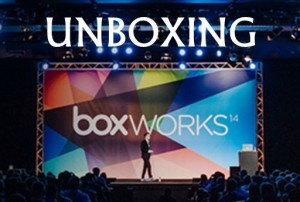In an era where every bit of information is stored, retrieved and analyzed, Box is aiming to redefine how content should be managed.
With the advent of the Cloud, Box is on the vanguard of helping enterprises manage vast amounts of content by making them available to anyone, anywhere on any device in a secure way.
Since 2005, Box has been doing that with great fanfare and considerable success. By investing heavily in sales and marketing, Box has experienced phenomenal growth and those investments could even be paying off in spades with projected profitability in 2017.
In 2014, Box grew its revenues 74% to $216 million, catapulting the vendor to the No. 49 spot in our Cloud Top 500 market report.
The upshot is that Box is sitting pretty with some 50,000 customers and 40 million users as well as a slew of new products and alliances that could propel the 10-year-old company to new heights.
At its recent user conference, Box showed off enhancements from image capturing to note-taking in its content management apps, security enhancements from legal holds, watermarking and device trust, along with alliances that could have far-reaching implications for its customers.
Verticalization of its content management strategy is another potential killer app as Box makes medical images such as DICOM, high-definition videos as well as engineering 3D drawings easily stored and managed in a single spot.
Aaron Levie, CEO of Box, said after making significant inroads into verticals like financial services, insurance and education, his company aims to boost industry-specific solutions for life sciences and public sector.
Having established itself as an easy-to-use tool for managing shared content from Excel databases to legal forms, Box is well positioned to take that further by harnessing rich data for industrial use from financial documents to loan origination processes.
What works to Box’s advantage is its ability to handle each and every piece of content securely in the Cloud, an attribute that has convinced many enterprises to gravitate toward Box from legacy content management offerings such as EMC Documentum, HP Autonomy and IBM Filenet.
For example, Box said a financial service customer has been moving its entire corporate content repository – consisting of 100 terabyte of data with 500 million files stored on its WORM drives for some 17,000 users – to Box.
And with the help of Box’s Enterprise Key Management offering, companies like General Electric have been able to enforce company-owned encryption control over how internal content and knowledge base can be shared securely among 300,000 GE users.
In addition to vertical opportunities, the next phase of growth for Box lies in its nascent platform strategy, which marries plenty of content assets with infrastructure components like storage, security, rules and workflow to build custom apps or portals. These efforts will leverage Box as the content services back-end for company branded apps that automate the provisioning of Box accounts and they do not require users to log into a Box account.
At the same time, corporate developers and ISVs will continue to retain policy control over how such metadata are being rendered, information rights granted and directory services authenticated in applications supported by the Box platform.
A good example that illustrates the power of the Box platform comes from IBM, its latest strategic partner. Under the pact, Box and IBM would integrate and resell their products and services and develop new custom solutions across industries. For example, a brewery could run a joint Box and IBM solutions to collaborate on the recipe workflow while optimizing the legal workflow in order to meet regulatory and compliance requirements.
IBM is extending its onpremise content management products like Filenet, StoredIQ, and Datacap to the Box platform, making it easier for their users to run their custom apps and search the underlying content all in the Cloud. In addition, the IBM Datacap integration allows Box users to have a unified experience when capturing and extracting content from different sources, and finally storing the results in Box.
Box already has tight integration arrangements with Microsoft Office and Office 365, DocuSign, NetSuite, Salesforce and many more. Adobe and Autodesk integrations are expected to be available in 2016.
Box Eyes Collaboration Opportunities
While Box is going full steam ahead with its vertical and platform strategies, the thinking goes if relevant and contextual content is within reach of Box users, collaboration should come easily.
At a time when its competitors in the onpremise world are busy reinventing themselves (as are the cases of Dell’s pending purchase of EMC and HP’s breakup into two companies), Box’s first mover advantage in Cloud content management has already turned previous rivals and doubters like IBM into partners.
While Box’s ability to dominate the content management apps market is far from certain, Box has been focusing on building out a platform to manage use cases for sync and share, now vying for much broader content management workflows while going after enterprise developers to build content centric apps on Box. Box competitors are not resting on their laurels. Almost every cloud platform vendor from Microsoft to Google has basic sync and share capabilities similar to Box. Dropbox remains a credible threat with its freemium approach and a deep pocket. The same applies to Slack’s successes in managing massive amounts of unstructured data for team collaboration and explosive growth as a result(adding $1 million in new annual recurring revenue every 11 days).
Box’s foray into notetaking apps underscores an opportunistic attempt to undermine Evernote further. However, a full-blown content creation product from Box could be an expensive value proposition from a development standpoint given its stated goal of turning a profit in 2017.
In addition it could be years away before Box can siphon shares away from Microsoft Sharepoint, which has attracted more than 100 million developers, administrators and users. Any organization that uses both Sharepoint and Box must address risks of incurring added costs and perhaps redundant tools for collaboration. Although in today’s consumerized IT environments, users are demanding and getting more choice in getting work done which bodes well for Box.
Still, there is plenty of room for Box to expand in key verticals and the deal with IBM could be mutually beneficial, allowing Box’s platform strategy to scale out by reaching legions of AS/400 and Domino developers, and conversely giving IBM’s SoftLayer Cloud hosting business the ability to displace Amazon Web Services or other Cloud providers now serving some of Box’s customers and ISVs.
Only ‘til then may Box be able to unbox and fully realize its magic with the power of next-generation content management.






